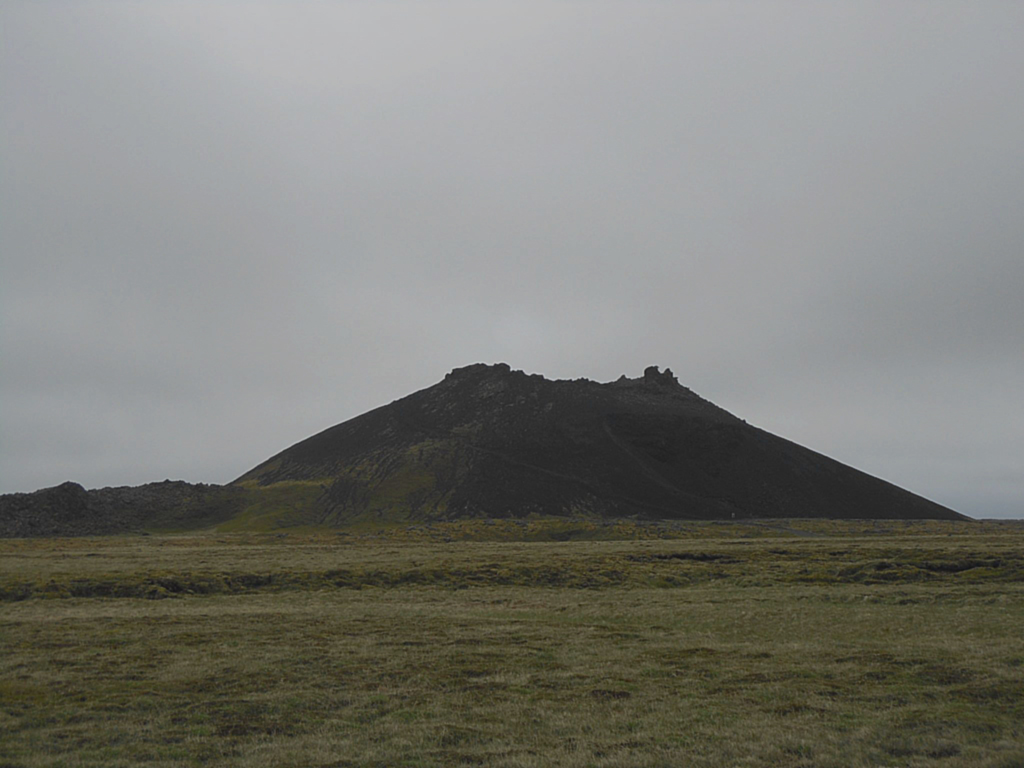Please take care when visiting this cache. The environment of Saxhóll is fragile and you are asked to help preserve it by only walking on the clear trail.
Scoria cones
Scoria cones are the commonest type of volcano and are also the smallest type, with modest heights of generally less than 300 metres. They often occur as single volcanic edifiices on basaltic lava fields, or as parasitic cones generated by flank eruptions on much larger, and older, shield volcanoes and stratovolcanoes, such as in this case the nearby Snæfellsjökull.
Scoria cones are composed almost wholly of basaltic tephra, ejected from lava fountains, or mildly explosive eruptions from a single vent which shoots melted rock fragments into the air. These cool rapidly as they pass through the air and fall back to earth, landing around the vent and accumulating in the typical cone shape.
Unlike the other two main volcano types, scoria cones have straight sides and large summit craters, relative to their overall size. When formed, the cone initially has very steep slopes, up to 35 degrees, with older cones typically coming to have much gentler slopes, from 15 to 20 degrees.
Scoria cones are often sources of lava flows, commonly of much greater volume than the cone itself. The lava almost always issues from the base of the cone, not from the top crater. This is because the cone is not strong enough to support the rise of lava within the central conduit. The lava, being much denser than the scoria, burrows beneath the cone, escaping from the more downhill side. This can result in parts of the scoria cone being torn off and carried away on top of the lava.
Most scoria cones only erupt for a single period of activity (which can vary from a few days, to several years), before passing rapidly into extinction, unlike shield volcanoes and stratovolcanoes, which usually display many eruption episodes over many thousands of years. If scoria cone activity does renew in the same general vicinity, it will usually be from a new, nearby, vent.
The Saxhóll Scoria Cone

The scoria cone at Saxhóll was formed between 3000 and 4000 years ago. In recent times, like many such scoria cones across Iceland, part of it has been quarried as a source of road and other construction materials. The old quarry now serves as a car park. A rough walking trail leads up from the car park to the rim of the crater, and along the top of the cone to a viewpoint, with panorama plate.
If you look carefully below you and to the left as you climb the track, you may be able to see the remains of a small lava flow which broke out from the base of the cone and spread off to the south west.
Please read the requirements for claiming this cache carefully. To claim this cache, you will need to do more than just read the description or look at infoboards. You will need to spend some time at the site, looking around and thinking about the questions. All of the answers can be found at the cache location, through observation and careful deduction!
To claim this cache:
You must visit the published coordinates and answer the following questions.
- The word "scoria" was originally a Greek word, meaning excrement. An alternative English name for volcanic scoria is cinder. On the walk to the cache coordinates, you will have become intimately familiar with the nature and form of cinders, as all of the ground you have walked on is made up of them. Please describe them to us in your own words. Include as many features as you can observe -- colour, shape, size, texture, density, strength, hardness and so on. What do the features that you can see suggest to you about the cinders' origin and the conditions under which they formed?
- Use your GPSr to determine the approximate altitude of the lava plain around the cone, and the altitude of the rim of the crater at the published coordinates. How high do you calculate the cone to rise above the lava field?
- On your ascent to the crater rim, you should be able to see several other scoria cones in the immediate area. What features of Saxhóll might lead you to conclude that it is not as old as most of these other cones?
- Referring to the view plate at the published coordinates, what is the nearest of the nearby cones called and how far away is it?
In addition, it would be nice to see a photograph of you and/or your GPSr at or near the rim of the cone (please don't fall into the crater!) included with your log. Please email the answers (in English please!) before logging your find. You do not need to wait for confirmation that your answers are correct before logging. If you are unable to email first but wish to log your find to maintain your caching sequence, please include an explanation for this in your log, saying when we can expect to have the answers. All logs submitted without answers (or an explanation for the delay) will be deleted without comment or warning. Please do not post answers to the questions in your log, or post any spoiler pictures that will help others to answer the questions without visiting the site. Please send your answers using the Geocaching.com contact link.
The Quietly Crew have created this cache to celebrate our latest trip to Iceland and as a "thank you" to the warm-hearted and generous people of this beautiful island who helped to make our stay so enjoyable and memorable. Wherever you are from, we hope you enjoy visiting this site and learning about the fascinating processes that have contributed to its formation.